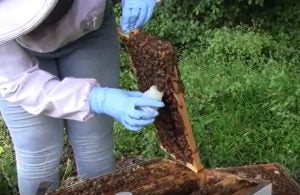The Annual Bee Informed Partnership survey results highlight the cyclical nature of honey bee colony turnover rates and the variety of factors affecting each new season
Beekeepers across the United States lost 43.7 percent of their managed honey bee colonies from April 2019 to April 2020, according to preliminary results of the 14th annual nationwide survey conducted by the nonprofit Bee Informed Partnership. These losses mark the second highest loss rate the survey has recorded since it began in 2006 (4.7 percentage points higher than the average annual loss rate of 39.0 percent). The survey results highlight the cyclical nature of honey bee colony turnover. Although the high loss rate was driven by the highest summer losses ever reported by the survey, winter losses were markedly lower than in most years.
As researchers learn more about what drives these cycles of loss, this year emphasizes the importance of the summer for beekeeper losses.
This past year, winter losses were reported at 22.2 percent, which is 15.5 percentage points lower than last year and 6.4 points lower than the survey average. However, high summer losses were reported at 32.0 percent, which is 12.0 percentage points higher than last year and 10.4 points higher than the survey average.
“This year, summer loss was actually the highest we’ve ever recorded, even higher than winter losses, which is only the second time we’ve seen that, and it’s mostly commercial beekeepers that are driving that loss number, which is unusual,” says Nathalie Steinhauer, BIP’s science coordinator and a post-doctoral researcher in the University of Maryland Department of Entomology. “So that makes this year different and interesting to us, because we want to know what is driving their losses up in comparison to previous years.”
Related reading: 12 interesting facts about bees
Commercial beekeepers typically have lower losses than backyard and smaller operations. Commercial honey bees pollinate $15 billion worth of food crops in the United States each year, so their health is critical to food production and supply.
“When BIP started doing this survey, winter loss was the main focus because that period of the year was thought to be the most challenging for beekeepers and their colonies, especially in temperate climates,” says Geoffrey Williams, assistant professor of entomology at Auburn University and co-author of the survey. “Adding summer loss into the survey in 2010/11 was quite revealing. For the first time, we had the numbers to show that loss occurs throughout the year, and that summers are not insignificant for beekeeper losses.”
Since beekeepers began noticing dramatic losses in their colonies in the early 2000s, state and federal agricultural agencies, university researchers, and the beekeeping industry have been working together to understand the cause and develop best management practices to reduce losses. The BIP annual colony loss survey, which has been conducted since 2006, has been an integral part of that effort.

The survey asks beekeeping operations of all sizes to track the survival or turnover rates of their honey bee colonies. This year, 3,377 beekeepers managing 276,832 colonies all across the country responded to the survey, representing about 10.4 percent of the nation’s estimated 2.67 million managed colonies.
According to Dan Aurell, BIP field specialist based at Texas A&M University, the factors that go into summer and winter losses are quite different, as are the consequences for commercial beekeepers, who seem to have struggled the most this past year based on the survey results. The health of the queens that head production colonies is a major factor in summer losses. In addition, beekeepers split their colonies after winter to strengthen them as a best management practice, and the health of those colonies at that time is critical to their longevity.
“Factors that often contribute to summer loss tend to be if your splits are in poor condition or don’t have the right resources, and queen failure,” says Aurell. On the other hand, winter loss is closely related to fall management practices, Aurell explains, such as whether your colonies have good conditions during the summer to build up to a robust fall population, and if the fall varroa mite loads were high.
“I’ve heard beekeepers say that the California queen raising season in 2019 was the worst in 30 years,” Aurell adds about one of the major queen-raising markets in the United States. According to Aurell and his colleagues at Michigan State University, UC Davis, and Oregon State University who all work with commercial beekeepers, this could have been a contributing factor.
Many of the summer losses this year could represent carry-over from a particularly poor winter last year, where BIP reported the highest winter losses it had ever recorded at 37.7 percent. Higher levels of the parasitic varroa mite reported that winter may have weakened colonies going into the spring of 2019. Additionally, weather conditions may have promoted brood diseases, affected the availability of mated queens when they were needed, or contributed to a lack of food for honey bees at key times throughout the year, such as during the almond blooms.
In addition to the loss survey, BIP conducts a management survey to connect management practices to losses, exploring ways to manage and reduce losses overall. However, according to the researchers, losses are a natural part of the beekeeping industry, rising and falling with the weather, varroa loads, pesticide loads, and a variety of other factors.


